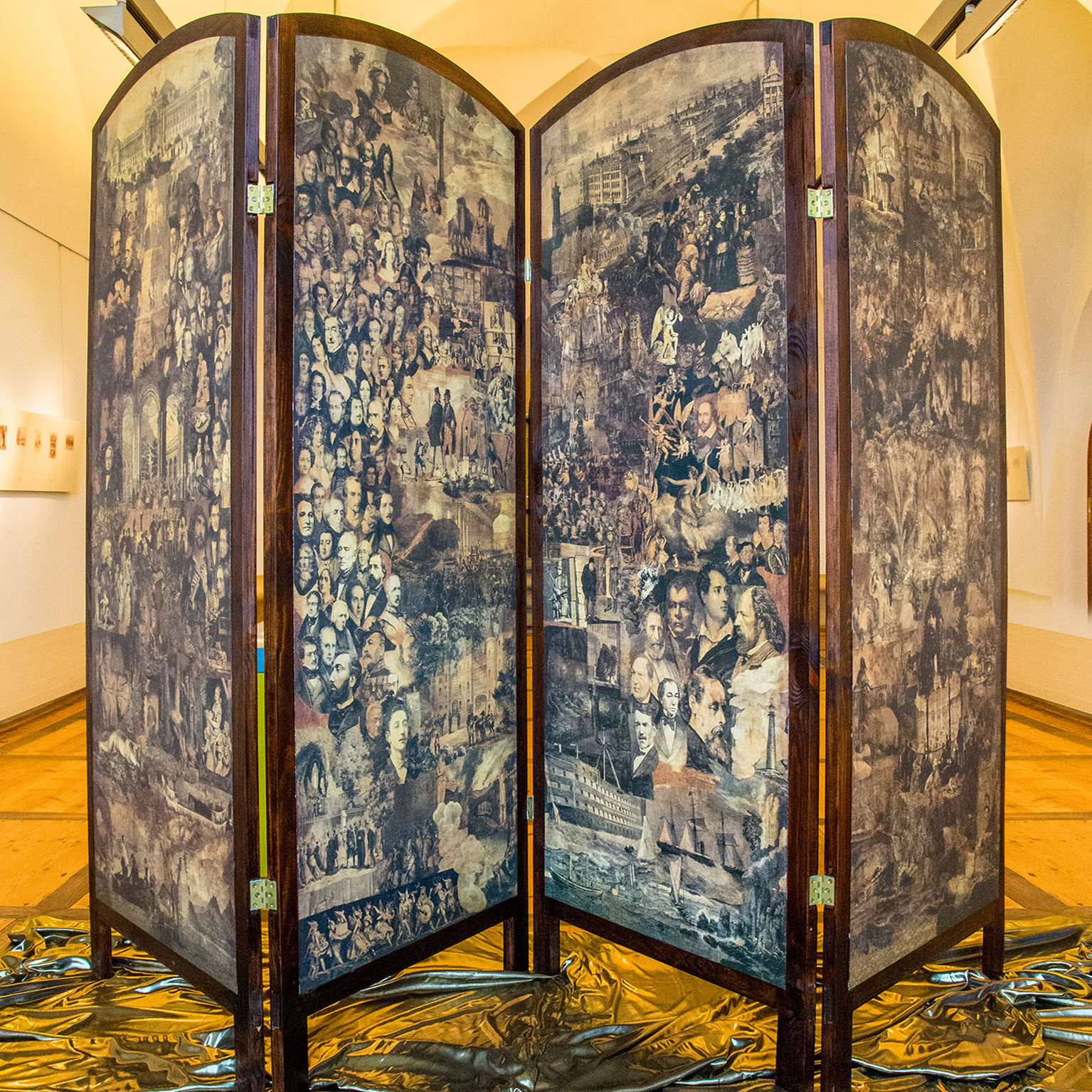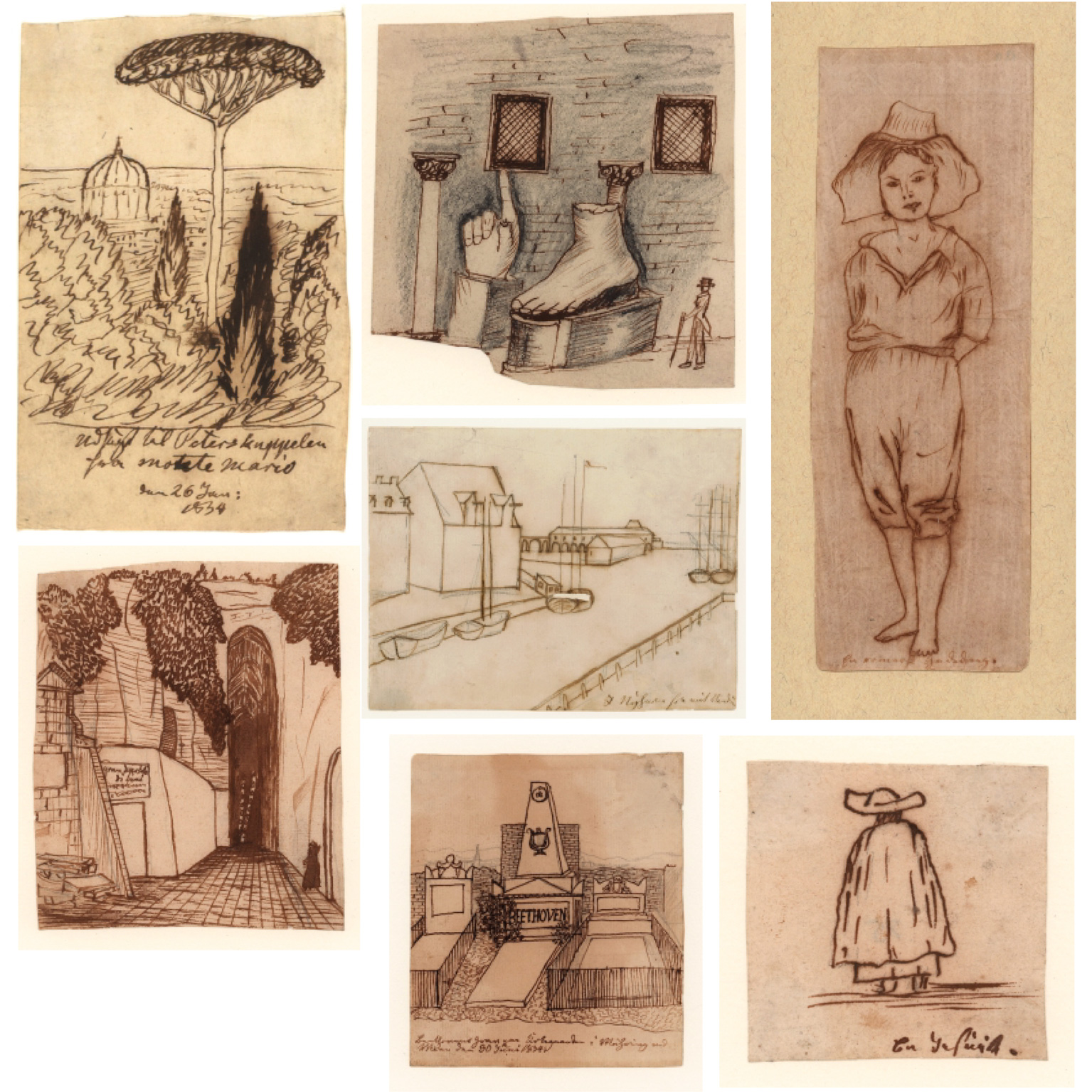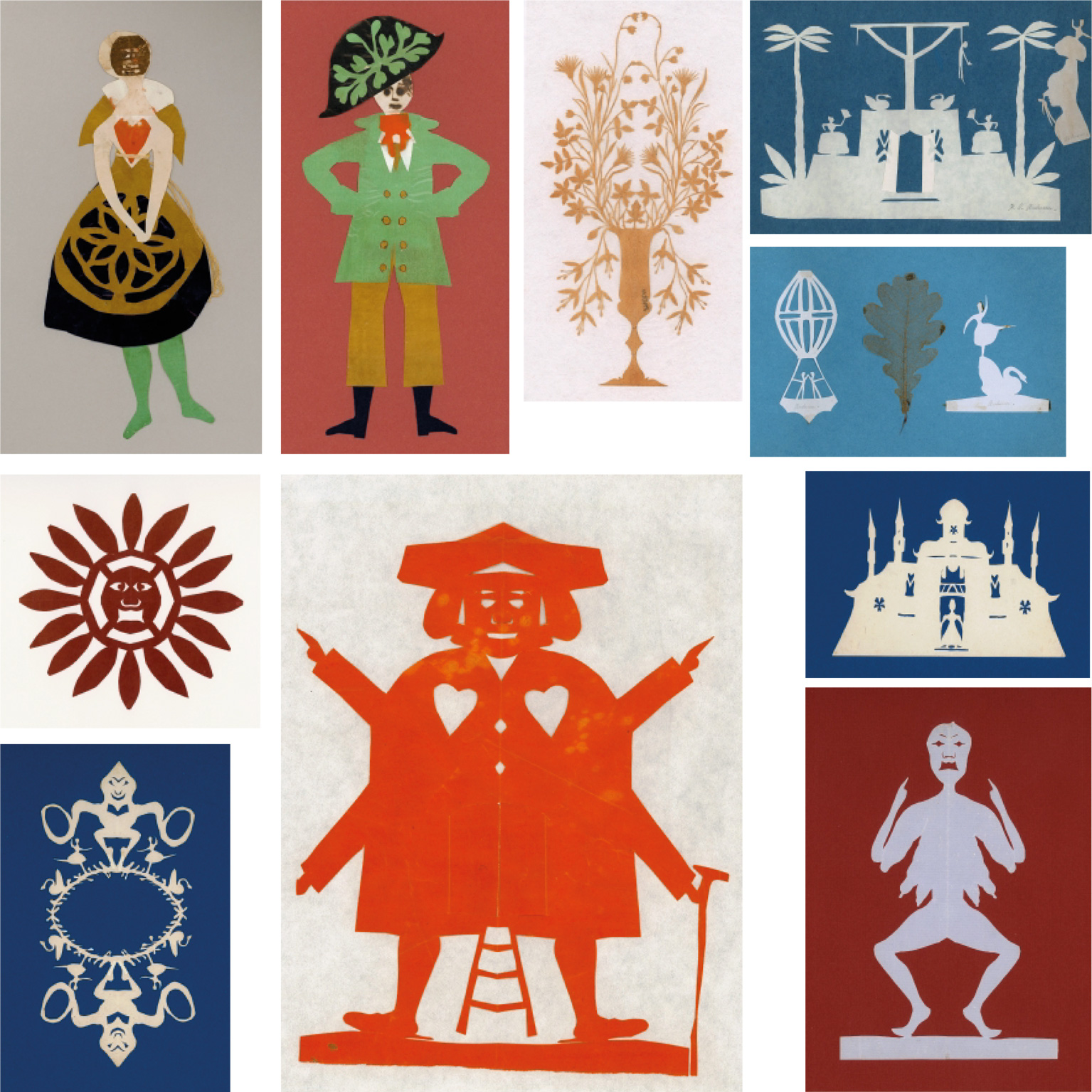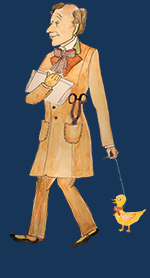



-
Hans Christian Andersen – Collages | Paper cuts | drawings
Hans Christian Andersen – a Dane and a European. He could only write his fairy tales in Denmark, but they are read and told all over the world. The current exhibition is dedicated to the diverse artistic work of this great man. The aim is not only to present Hans Christian Andersen as a fairy tale writer, but also to present his unknown sides.
Andersen was a universal artist and artist of life. He became famous with his fairy tales, but he was also a visual artist throughout his life. He combined many talents and, in addition to his writings, continuously created drawings, collages, picture books and silhouettes.
Andersen’s pictorial variety and his creative informality in dealing with the fine arts are presented in the exhibition. It contains a series of the most beautiful and expressive silhouettes, picture books, drawings and collages from Andersen’s creative fund.
The collection was put together by MÄRCHENLAND and the Royal Danish Embassy in Berlin in the course of the anniversary year 2005 on the occasion of the artist’s 200th birthday with the support of the Odense Museum and the Hans Christian Andersen Fund. Since then it has been shown to the public in several exhibitions: in the Felleshus of the Nordic embassies in Berlin, at Corvey Castle near Höxter and at the Albrechtsburg Castle in Meißen.
“… people say the whole thing is like a big colorful fairy tale.”
H.C. Andersen about the screen to Mimi Holstein, March 1874
Collages are a combination of smaller prints and image sections made from a wide variety of materials. They were created as early as the 19th century, not least by Andersen’s hand.In the 1960s and 1970s, “paper poetry”, as Andersen called his collages and silhouettes, took on an increasingly important place in his work. One of the most impressive works is the screen from 1873-74. This is covered all over with pictures and originally stood in front of Andersen’s bed, hiding it and forming a partition in the room.
The screen consists of eight panels, each dedicated to a country or idea: childhood, theatre, Denmark, Sweden-Norway, Germany-Austria, France, England and the Orient. Common to all panels is the horizontal line with the most distinguished persons and most magnificent buildings and monuments at the top. Below that, in chronological order, are the most important poets, thinkers, and statesmen of that country, and at the bottom in cellars and caves are the anonymous and the poor, the drunks and the criminals.
Andersen got the idea for this large scissor work from Countess WandaDanneskjold, who had given him a smaller, self-made screen and about which Andersen wrote in his diary: “… with colored pictures on one side and uncolored ones on the other side, cut out, glued together, like merging a single image and yet infinitely many, they slipped into each other like a strange dream, all arranged with taste and imagination, this gift made me particularly happy.”
Andersen’s large screen celebrates the cultures, landscapes and people that shaped his life and is his attempt to express the entire cultural landscape through which his life has taken him.


“By the way, I’ve become a passionate sketch-maker, my portfolio is full of little views of Italy, I’d like to put the whole country in my pocket.”
H. C. Andersen to Christian Voigt, 1833
Just as strong as the urge to write and travel was Andersen’s urge to draw. On paper he had cut to the size of his jacket pocket, Andersen drew while traveling in Europe. He drew in pencil the scenes that aroused his interest, and when he came home from the day’s outings and walks he traced the sketches with pen and ink. Pen and ink drawings were Andersen’s preferred form of expression as a visual artist in the 1830s and 1840s, and some three hundred of these have survived.Most of his drawings come from his two major trips: the “educational trip” to Italy in 1833/34 and the “oriental trip” to Greece and Turkey in 1840/41. The artistic intentions of Andersen’s drawings have long been unfairly trivialized. In a travel letter, Andersen wrote: “…since my first arrival in Rome and ever since I was praised there for my sketches – for I must be praised in order to be well – I have drawn at every opportunity.”
There are many indications that after his trip to Italy, Andersen used the numerous sketches of landscapes and architecture very actively in his work on the novel The Improviser (1835). But what characterizes the drawings? Kjeld Heltoft, who studied the drawings, writes: ‘The innermost secret of the drawings is difficult to define, although it will always be sought; the innermost is the correspondence between the expressive noteworthy – the mood of the here and now – and the attempt to portray the enduring that has endured for so long despite everything. They all exude a sense of déjà vu.”
“…cutting is the beginning of poetry…”
H.C. Andersen in a letter, July 1867
It was entertaining for both children and adults to see Andersen snipping with the scissors he always carried with him. He was extremely popular as a paper cutter, and many of the paper cuts were cut up during his lifetime and given to admirers as souvenirs. While the poet was cutting, he liked to tell a fantastic story that would not end until the paper cut was complete and ready to be unfolded. Often the paper output underscored the punchline or motif of the story being told.The surprising shapes and unusual figures that erupted from his scissors with all of a sudden were an expression of Andersen’s powerful imagination and creative energy.
The child-friendly poet also used scissors to make toys for children’s rooms: dress-up dolls, figures that could move and so-called mill men that could be set up or hung decoratively in the window. His old love of the theater reappeared in entire scenes with dancers and ballerinas, with curtains, backdrops and an orchestra pit.
About 800 of Andersen’s silhouettes still exist today, most of them from the last twenty years of his life. Motifs include swans, dancers, butterflies, hearts, pierrots, leprechauns, balloons, etc. These fun, decorative and very elegant paper cutouts, which Andersen loved to make in convivial circles, form a refined fairytale world of recognizable motifs. But this lovely and pleasing world is broken up by a completely different, heavy imagery and expanded by devil figures, mermaids, grotesque Medusa heads, witches and trolls. They are peculiar creatures, neither human nor animal, which seem strange and have their roots in other depths of the imagination.

“Life is the most beautiful fairy tale, because we appear in it ourselves.”
 Hans Christian Andersen was born on April 2, 1805 in Odense on Funen in Denmark and grew up in poor circumstances, the son of a shoemaker and a laundress. He dreamed of becoming famous at the Royal Theater in Copenhagen and left for the capital in 1819 at the age of fourteen. With a special mixture of naivety, self-confidence and stubbornness, he gained access to a number of influential Copenhagen families, to whom he recited his poetry, recited passages from operas and danced. They supported the young, destitute talent financially and ensured that he received a proper education. His life was shaped by traveling throughout Europe – he was on the road for months in Germany, Southern Europe, France, England and Scandinavia and even got to North Africa and Turkey. His life and work were particularly shaped by his artistic and personal ties to Germany – his so-called “second fatherland”.
Hans Christian Andersen was born on April 2, 1805 in Odense on Funen in Denmark and grew up in poor circumstances, the son of a shoemaker and a laundress. He dreamed of becoming famous at the Royal Theater in Copenhagen and left for the capital in 1819 at the age of fourteen. With a special mixture of naivety, self-confidence and stubbornness, he gained access to a number of influential Copenhagen families, to whom he recited his poetry, recited passages from operas and danced. They supported the young, destitute talent financially and ensured that he received a proper education. His life was shaped by traveling throughout Europe – he was on the road for months in Germany, Southern Europe, France, England and Scandinavia and even got to North Africa and Turkey. His life and work were particularly shaped by his artistic and personal ties to Germany – his so-called “second fatherland”.The first trip abroad in 1831 was a journey of discovery through Romantic Germany. During this trip he visited Berlin and Dresden, where he received the “poet’s kiss” from the great romantic Ludwig Tieck. The great poet kissed Andersen on the forehead goodbye, encouraging him to continue on the path of poetry. Andersen’s multiple stays in Germany in the 1940s quickly made him famous. He made contacts and made acquaintances with famous people, thinkers and poets. He met Adelbert von Chamisso, who introduced him to literary society in Berlin, as well as the philosopher Friedrich W. Schelling, Bettina von Arnim, the Brothers Grimm and Alexander von Humboldt.
THE PRINCESS AND THE PEA
Art Fairy Tales, H. C. Andersen, c. 1835-1837Once upon a time there was a prince who wanted to marry a princess. But that should be a real one be a princess. So he traveled all over the world to find one, but everywhere something was missing. There were enough princesses, but whether they were real princesses he could tell never find out. There was always something that wasn’t quite right. Then he came back home and was very sad because he really wanted to have a real princess.
One evening terrible weather came; there was lightning and thunder, the rain fell, and it was absolutely awful. Then there was a knock at the city gate, and the old king went to open it. It was a princess standing outside the gate. But how did she see the rain and that bad weather out! The water ran down her hair and clothes, ran into the beaks of the Shoes in and out again to the heel. She said she was a real princess.
“Yes, we’ll find out soon enough!” thought the old queen, but she didn’t say anything, went to the Got in the bedroom, took off all the bedding and put a pea on the bottom of the bedstead. Then she took twenty mattresses, put them on the pea, and then twenty more eiderdown comforters on top of the mattresses. This is where the princess should lie all night.
In the morning she was asked how she had slept. “Oh, horribly bad!” she said Princess. “I haven’t closed my eyes most of the night! God knows what’s in my bed has been. I was lying on something hard, so my whole body was all brown and am blue! It’s horrible!” From this you could see that she was a real princess, because she had felt the pea through the twenty mattresses and twenty eiderdown comforters. Nobody could be that sensitive except a real princess.
So the prince took her to wife, because now he knew that he was a real one princess had found. And the pea came to the Kunstkammer, where it can still be seen if no one has stolen it. – Look, that was one real story!
